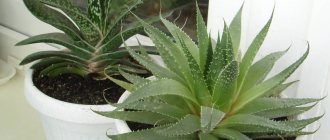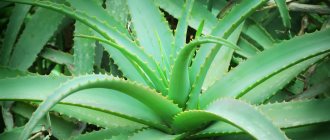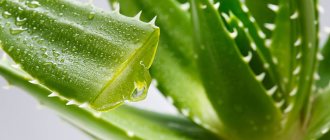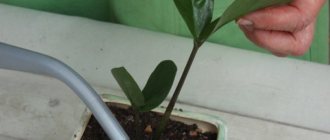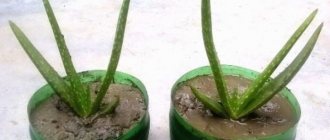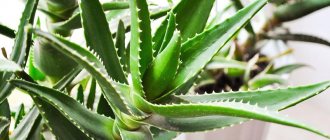The aloe plant, also known to many as agave, has earned popularity due to its healing properties. The leaves of this plant are used to prepare various healing ointments and tinctures. For this purpose, one plant is not enough, and it becomes necessary to grow several more specimens. Here, many amateur gardeners are faced with a problem: how to propagate aloe at home.
There are several ways to propagate aloe. They differ from each other in complexity and in the time that needs to be spent on one or another method. However, it cannot be said that one breeding method is worse and another is better. All of them are equally good and, if followed correctly, lead to positive results.
Features of aloe propagation
Aloe propagates indoors easily. After all, it is unpretentious, and attempts to breed it in 99% of cases end in success. Aloe, like many other succulents, is capable of propagation by the vegetative method, i.e. a part taken from one plant can be rooted and another flower can be grown from it.
Flower growers are familiar with several effective ways to propagate aloe indoors: leaves, children, cuttings, tops and seeds. Each of these methods has its own characteristics; even the most inexperienced gardener can propagate aloe.
Growing from a leaf without roots
How to plant aloe vera with leaves without roots? This is a very practical method, it requires:
Pinch off the adult fleshy leaf at the very base.- Sprinkle the cut with activated carbon powder.
- Dry the planting material for three to five days.
- Place drainage in the container and top with soil mixture.
- Place a layer of coarse sand on the ground.
- Immerse the bottom of the leaf in a damp substrate to a depth of five centimeters.
- Cover with a glass jar.
- Spray the sand regularly as it dries.
- A week later, when the first roots appear, turn on the watering.
- When the leaf begins to grow, transplant the young aloe bush into a pot filled with succulent soil.
Leaves
The least labor-intensive way to propagate agave at home is to propagate aloe leaves. First you need to carefully examine the leaves on the plant and choose the thickest and strongest of them. Such leaves are located at the bottom of the flower.
You should not choose leaves that have a yellowish or brownish tint. Those with stains on the surface are also not suitable.
These signs indicate that the leaf is unhealthy, and a damaged leaf will not grow into a strong plant. The selected leaf must be cut at its base as close to the stem as possible.
The cut leaf should be placed in a dark room and wait until the cut dries and a thin crust forms on it. As a rule, it takes no more than 3-5 days. When such a crust has appeared, you can move on to the next stage. You need to take 2-3 tablets of activated carbon, crush them into powder and sprinkle them on the cut area of the leaf. You can also use charcoal for this procedure. Immediately after this, you need to stick the leaf into the previously prepared soil so that the cut is underground at a depth of 3-5 cm.
An excellent soil for aloe will be soil with the addition of peat and sand. It is necessary to keep the soil moist at all times and not allow it to dry out. Well-moistened soil guarantees that young aloe will quickly take root and develop properly.
How to propagate aloe vera?
In the wild, aloe vera is most often propagated by seeds or root shoots. If in the natural environment flowering occurs regularly, a long stem with clusters of flowers of various colors is formed on the succulent, then at home you can wait several decades for the appearance of a peduncle and the ripening of seeds. Does aloe vera help acne?
Therefore, propagation of aloe at home is carried out not only by seeds; it can be propagated in other ways:
- developed leaf;
- young basal shoots (children);
- cuttings.
Reproduction of the flower by all means gives good results; if the recommendations are followed, the plant takes root successfully. It is useful to know, for example, how to propagate aloe at home in two ways: leaves and seeds.
It is best to propagate aloe vera from young shoots.
How to grow from a leaf?
To propagate the plant using this method, planting must be done in spring or early summer. How to grow aloe from a leaf correctly? Desirable for successful reproduction:
- use an old plant;
- pinch off a healthy, strong leaf at the very base;
- Sprinkle the disconnection area on the flower with pre-crushed charcoal or activated carbon.
Propagation of aloe using leaves at home does not involve the use of a knife or scissors. Planting material is pinched off by hand. After the material has been plucked off, it is necessary to prepare it and the soil for further planting.
Preparation
Place the torn leaf in a dark place, away from light, and leave until the cut dries, on which a thin crust should naturally form.
This takes approximately 5-7 days. The dried cut should be treated with activated charcoal or ash. In order for aloe leaf propagation to be successful, you need to prepare a high-quality sand-soil mixture to which peat is added:
- Place drainage at the bottom of a small pot;
- Approximately 2/3 of the container is filled with soil of the same composition as the mother flower, or an acidified mixture for cacti purchased in a store;
- Sprinkle sand onto the remaining 1/3 of the pot.
The resulting soil mixture must be moistened. Now you can propagate aloe vera in it.
Planting a shoot
Insert a leaf kept away from light for 5-7 days into the moistened soil prepared for propagation to a depth of no more than 2-4 cm for rooting. Water constantly until roots appear.
Important! Excessive watering of the rooted shoot can lead to rotting of the roots that have barely appeared. To avoid waterlogging and successfully propagate the flower, it is more convenient to use a spray bottle.
How to grow aloe from a shoot so that it is strong, healthy and tolerates transplantation well? It is possible to propagate aloe using this method if several conditions are met. The room in which the pot is located must:
- well lit;
- ventilate regularly;
- have an optimal air temperature: +25°C.
Tip: for preliminary deepening of aloe for the purpose of rooting, wet sand is suitable instead of soil mixture.
After the leaf takes root (after about 2 weeks), the established shoot must be replanted in order to propagate. Water the young plant.
Propagation from seeds
How to grow aloe from seeds at home, on the windowsill?
Propagation of aloe is a rather labor-intensive and time-consuming process. But it is convenient to propagate it in this way if you need to get many young plants at once. Seeds are sold in specialized stores. Their packaging usually contains instructions on how to properly grow aloe and what needs to be done to propagate it. To propagate aloe, it is better to sow seeds in late February - early March. Use a shallow container with holes in the bottom. The soil should consist of:
- earth mixture of rotted leaves and turf - 1 part;
- clean and steamed river sand - 2 parts.
To propagate a plant by seeds, you must perform the following steps:
- pour 1 part of a mixture of leaf and turf soil onto the bottom of the container;
- spread the seeds on the surface of the soil;
- sprinkle the seeds with 2 parts of sand;
- moisten the soil - lower the container into a bowl of water for a few minutes;
- then place the seedlings in a bright room (but not in direct sunlight) with an air temperature of +20-22°C;
- Moisten the soil periodically with a spray bottle.
Information: if aloe vera is grown at home according to all the rules, the seedlings will germinate approximately 5-6 days after planting.
After 1 or 2 leaves appear on the emerging seedlings, the plants are planted in small pots. The soil is used of the same composition as when sowing seeds. After 1 year, the grown shoots are planted in separate large pots.
Cuttings
Cuttings are a common method of propagating many indoor and garden plants. This method can be used at any time of the year. However, most experienced gardeners agree that it is easiest to achieve a positive result with its help in the summer.
Propagation of aloe by cuttings is possible if the plant has lateral branches along the stem. Just as in the case of agave propagation by leaves, cuttings should be cut almost at the very base, as close to the stem as possible. Cut cuttings should be prepared for planting by placing them for a week in a dark room with air humidity of at least 50%. This is necessary to dry the cut.
After 7 days, the cutting with the dried cut must be removed from its storage location, sprinkled with activated carbon on the cut and planted in the ground. It is enough to deepen the cuttings into the ground only 2-3 cm. If several cuttings are planted in one container at once, the distance between them should be at least 10 cm, since with good watering the aloe will begin to grow quickly and the plants will become crowded.
Soil requirements
For young aloe, you should prepare soil that has the following characteristics:
- Loose. Does not retain moisture and has good air permeability.
- Neutral or slightly acidic.
- Contains a lot of iron.
The mixture should include turf and leaf soil, humus and sand. Take twice as much turf soil compared to other components. Add a little charcoal to the soil for disinfection and some small stones to make it loose. It is best to buy a special mixture for succulents and cacti . Such a substrate contains all the nutritional components necessary for the development of a young plant.
Tip : Immediately before planting, you need to disinfect the soil - keep it in the oven for half an hour at a temperature of 90°C. Be sure to add a drainage layer of pebbles, expanded clay or small shards to the bottom of the pot.
Children
Aloe shoots are called shoots that grow around the main flower from its root system. These shoots are often called appendages or root shoots. Propagation of aloe by this method occurs naturally and requires almost no human intervention. But aloe vera reproduces at home in this way slowly. It may take many years before the first shoots begin to emerge from the soil around an adult plant. Therefore, if the question is how to propagate aloe quickly, you should not rely on this method.
However, if shoots appear around the agave in a pot, you just need to separate the young shoots from the adult plant and plant them in a separate container. The main difficulty of this method is to avoid damaging the root system during replanting. Therefore, the soil must first be moistened, which will allow the shoots to be carefully removed.
Types of aloe for propagation
There is no universal solution on how to propagate a particular type of aloe. The methods are the same for all varieties. Flower growers who breed these plants use methods that are most convenient for certain species. Everyone chooses for themselves how to grow aloe in their home.
Young aloe shoots
Faith
Aloe vera is the most popular species to grow at home. Its distinctive features are a short stem and long fleshy leaves collected in rosettes. The leaves are light green in color, covered with whitish spots, and have sharp thorns along the edges. They practically do not bloom, so propagation by seeds is practically impossible for aloe vera. Most often, reproduction of aloe of this species occurs by the apical method or with the help of shoots.
For your information! Aloe vera varieties differ in leaf color depending on their place of origin. They all have equal healing properties.
Aloe vera
Aloe arborescens
It is more often called the agave because its lifespan is simply amazing. Its main characteristic is the long, pointed, elongated leaves attached to the stem. Thanks to them, it becomes clear how to propagate aloe vera - by rooting the leaf.
Agave
Aloe variegated (tiger)
It is characterized by the variegated color of long (up to 30 cm) leaves, due to which the flower got its name. The most convenient methods of propagation: from tops or seedlings.
Aloe variegated
Aloe fan
Externally it is a shrub with a gradually woody stem. The leaves are round, long (up to 30 cm) and wide (up to 5 cm). A distinctive feature of this species is the way Aloe fana propagates. It is characterized by seed propagation, which is rare for succulents. It blooms quite often, and with proper care it does so every year. Scarlet flowers are located on long thin stems.
Aloe fan
Important! Everyone decides for themselves how to propagate aloe; the main thing in this process is not to harm the adult plant - not to leave damage on it. But the rooting process itself is very simple, even novice gardeners can handle it.
Tops
Propagating aloe from the top is the fastest way to get another plant. To do this, you just need to cut off the top of an adult flower so that it has at least 7 leaves. To achieve the best result, you can pre-soak the cut top of the plant in a solution with the addition of phytohormone growth.
Immediately after this, you need to place the top in a container with warm water, cut side down, and wait for the roots to form. Roots begin to appear after 7-10 days. As soon as the first signs of the formation of a root system appear, the plant must be immediately planted in the ground and actively watered, without allowing the soil to dry out.
How to plant at the top?
- Advantage: simple and easy method to implement.
- Disadvantage: cutting off the top causes injury to the plant.
- The cut off top with leaves is placed in warm water.
To do this, it is better to place a cardboard with holes on a jar of water so that only the lower part of the top comes into contact with the water. You can add a couple of drops of a plant growth stimulator (for example, Epin extra) to the water. - As soon as the first roots appear, the seedling is planted in a prepared pot.
Important! To avoid rotting of the root system, aloe should not be over-watered.
We talked about how agave blooms at home and why sometimes it does not bloom and what the difference is between the properties, use and cultivation of agave and aloe vera on our website.
Seeds
Propagating aloe by seeds is the most difficult and time-consuming of all ways to grow it at home. This method is complicated because it is rare to obtain plant seeds. They form in an adult plant only after a flowering period, and agave blooms rarely under indoor conditions - approximately once every 10 years.
If you still managed to get the seeds, you will have to germinate them according to the following scheme. First, you will have to select a suitable container, fill it with moist soil and deepen the seeds into the soil no more than 2-3 cm. Then the container with the seeds planted in the soil must be covered with glass or film and kept in a room where the temperature will be maintained around the clock at approximately + 21°C.
Aloe from seeds germinates in at least 7-10 days. Sometimes the period can reach 3 weeks. With the appearance of the first shoots, the film (or glass) can be removed. As soon as the seedlings grow and become stronger, they will need to be planted in separate containers. It is important that the composition of the soil in the container for replanting is exactly the same as in the previous one, otherwise the young, fragile aloe may die.
In about a year, the still small but already stronger plant will again have to be transplanted into a larger container, since by that time the young agave will already be cramped in the old pot. Propagating aloe vera from seeds is a difficult task that requires a lot of time and effort.
Features of growing at home
Despite the fact that growing aloe at home is not difficult due to its amazing unpretentiousness, its propagation requires the implementation of certain rules of care. To propagate a flower without letting it wither or even die, it is important to pay attention to:
- proper placement;
- selection of optimal climatic conditions;
- useful fertilizers;
- timely control of pests and diseases;
- correct watering.
It is useful to know how to grow aloe at home, taking into account these rules, what are the features of the propagation process.
Recommendations for caring for young plants
Aloe is an unpretentious flower and does not require special care at home. But while the young agave plants are not yet strong enough, they should be treated with great attention. There are several simple rules on how to properly care for a flower.
In the room where the aloe is located, the temperature should not fall below +14°C or rise above +21°C. The indicated temperature range is the most optimal for this flower; at this temperature it will grow quickly.
Aloe loves bright light, but direct sunlight can burn the leaves of young plants, causing them to lose color. To grow a healthy and strong flower, you need to gradually accustom it to sunlight. It would be a good idea to place aloe on the balcony or in the yard for several hours a day, gradually increasing the time the plant stays in bright light. In the winter season, when there is not enough natural light, it would be useful to organize additional artificial lighting for aloe.
Adult plants can go without watering for a long time, but while the flower is still young and fragile, it is necessary to carefully monitor the condition of the soil and not allow it to dry out. A sufficient amount of moisture will allow the agave to grow quickly and develop properly. The flower does not need additional spraying of the leaves and maintaining high air humidity in the room; the moisture obtained from the soil is enough for it.
In the summer, the plant can be planted in a flower garden in the yard. But under no circumstances should you leave it there with the onset of autumn. After all, the homeland of aloe is Africa, where the climate is much warmer than ours and there are no frosts. For this reason, the flower does not tolerate frost and may die when the temperature drops.
How often to water?
How often to water aloe when propagating?
The succulent has fleshy leaves, as well as roots that accumulate water, so it does not require frequent and abundant watering during the propagation period. Excessive moisture and stagnation of water can lead to rotting of the roots and will not allow aloe to reproduce. You need to make sure that the soil in the container is dry, and only then wet the top layer. How to water aloe in summer and winter to successfully propagate it? In summer, once a week is enough. In winter, the need for moisture is significantly reduced. Reduce both the amount of water (2 times) and the frequency of watering: once a month is enough
How to water aloe at home so as not to harm it and reproduce successfully? It is most effective to immerse the pot in water for a few minutes. During normal watering, it is necessary to ensure that moisture does not get into the aloe outlet. To propagate the plant without rotting, you need to pour water at the root.
If you are interested in how a mango tree grows, take a look here. Is it possible to grow banana or ginger at home? Treat cough with aloe juice.
Preparing pots and soil
Late spring and summer are the time of active growing season and are best suited for planting. Young plants will need plenty of sunlight and heat to adapt.
The dishes needed for planting beginners are ordinary flower pots made of clay or plastic. It is not advisable to plant a sprout in a tiny pot; to ensure normal moisture exchange and freedom of the root system for one sprout, it is more useful to take a container with a capacity of at least 1 liter.
If you need to detach several shoots from a large plant and then replant them after rooting, it is recommended to use special long containers. A prerequisite is the presence of several small holes in the bottom to drain excess moisture.
Before use, containers are thoroughly washed with soapy water or treated with phosphates.
In the wild, aloe grows on desert sandstones and clay soils and is content with a meager amount of moisture. For planting at home, it is best to purchase special soil from a flower shop.
You can also prepare a mixture of ordinary garden soil with coarse sand or fine brick chips. For 3 parts of soil, take 1 part of sand, crumbs or shell rock, mix thoroughly and moisten. You can add a little peat or wood ash to the substrate. Place a layer of fine gravel or wet sand at the bottom of the pot, then pour in the prepared soil.
We recommend: Aloe vera - description, care, propagation
Care after landing
- Immediately after planting, aloe should be placed in a cool place, protected from direct sunlight. Then transfer to a sunny windowsill.
- Water once or twice a week, waiting until the top layer of soil dries. Use warm, settled water.
- To remove accumulated dust, wipe the leaves with a damp cloth. Do not spray.
- Maintain the room temperature at least +20°C in spring and summer and at least +14°C in winter.
- Regularly ventilate the room where the flower is located.
- If special soil for succulents or cacti was used when planting the plant, fertilizing is not required for eight to nine months after planting.
- Inspect young agave for pests or diseases. If scale insects or aphids are found on leaf blades, wipe them with a piece of cotton wool soaked in alcohol. Or spray with garlic tincture.
How to care for agave at home is discussed here.
Our experts have prepared for you other articles about tree aloe:
- Traditional medicine recipes with agave.
- What is the difference between aloe and agave?
- Features of agave flowering.
- Medicinal properties of agave.
How to get a new bush from a shoot?
Aloe babies are young underground shoots that grow at the base of the root . These shoots have their own root system. Their other names are appendages, root shoots. The main advantage of the method is its ease. Children form naturally; you just need to carefully separate them from the main plant. Using this method you can grow several bushes.
How to grow a bush from a shoot? First of all, you should remember that the formation of new appendages takes a lot of time. It is better to carry out propagation during the process of transplanting the main plant.
Selection and separation of children:
Moisten the soil in which aloe grows.- Remove the plant from the pot and inspect it.
- Determine the degree of maturity of the roots of the shoots.
- Use a sharp garden spatula to separate the appendages from the mother plant. Avoid damaging the root system. Leave the damaged shoots to dry for several days.
Landing:
- Prepare containers.
- Place drainage at the bottom.
- Pour in a special substrate.
- Moisten the soil.
- Half an hour after watering, when excess water has drained, plant the shoots. To do this, deepen them into the ground one centimeter.
- Water daily for the first 10 days.
How quickly can aloe root? Usually rooting occurs within a month and then new leaves appear.
We recommend watching a video about the propagation of aloe by children:
Growing aloe arborescens
A perennial tree plant of large size, it grows in a tropical climate, which means that the temperature for its normal development must be above + 25 degrees. Aloe vera does not require high humidity, and will feel calm in a room, on a windowsill, even next to heating appliances.
What aloe really does not tolerate is frost and waterlogging. Therefore, in warm latitudes, aloe vera can be grown in garden plots.
Aloe is a light-loving, heat-loving plant that must be protected in open ground from temperature changes.
Outdoor aloe, over time, can tolerate temperatures dropping to +2 degrees. However, one should not assume that the plant is able to survive the winter; during the cold season, the tree-like aloe bush is dug up and moved to a covered room with a temperature suitable for its existence.
The aloe bush, like other cultivated plants, prefers nutritious substrates and needs feeding. With proper care, indoor aloe produces 8-10 shoots every year, which can subsequently become seedling material. Growing aloe does not require large areas or exhausting care measures.
A pre-prepared substrate (mixed turf soil with sand 2:1) is poured into small pots or any other container with drainage holes. The cut areas of aloe side shoots are pre-dried and then planted in prepared pots with substrate to a depth of about 5 cm.
It would be a good idea to place an additional layer of sand or fine gravel under the planting soil to better drain excess moisture. After planting, the “babies” are placed in greenhouses or placed on windowsills on the sunny side.
After planting, for better rooting, the top layer of soil is kept moist constantly for about a month; the optimal temperature during this period is considered to be +25-27 degrees. After a year, young seedlings can be transplanted into open ground or into a larger pot for further growth and development.
Aloe propagation occurs not only vegetatively, but also by seeds. If during flowering it is possible to collect aloe seeds, then they can also be planted in prepared soil, moistened daily and warmed by sunlight, and when the seeds germinate and have at least three leaves, they can be transplanted into open ground in the month of May. In the south, the plant takes root well, and in northern latitudes, aloe is grown exclusively in greenhouses.
Many gardeners are faced with the problem of lack of aloe flowering. To make a plant bloom, you need to change its usual place of growth and give it a “shake-up”, place the flower in a darkened room with a low temperature for a couple of weeks until a peduncle appears.
Afterwards, the pot with the flower is returned to its usual place and fertilized with mineral fertilizers. Flowering lasts about two weeks, and after that, a seed box with seeds appears, which in the future can be planted in a new pot.
Rooting cuttings and layering
Cuttings and layering can be rooted in water and soil.
The first method sometimes leads to their rotting, so you only need to place the cuttings in boiled water at room temperature.
Water should not get into the rosette of leaves, so it is better to root very short layerings of bush varieties in the ground.
Cuttings standing in water take root within 2-3 weeks . As soon as the roots grow to 4-5 cm, young plants can be planted in the ground.
When rooting in the ground, dried parts of aloe are planted to a depth of 2-4 cm, depending on the size of the cutting. The soil should not be wet, but only slightly damp.
After planting, the cuttings are not watered for 2-3 days . After this, very moderate and careful watering begins. They are not covered with glass or film, and the temperature is maintained within 18-26°C.
You cannot constantly moisten the mail, the soil must dry out
The soil should not be kept wet all the time - it should dry out. This will not in any way affect the state of the developing root system of the cuttings - the roots grow in both wet and dry soil.
The main thing is not to over-moisten the soil, as this easily leads to rotting and death of young plants. Cuttings take root and begin to grow in 2-4 weeks.
Properties of aloe
The use of aloe has been known for a long time; the plant is an excellent remedy in the fight against acne, acne and redness.
Aloe is used for constipation, as an immunostimulant, to eliminate post-burn injuries, skin damage, bronchitis, conjunctivitis, gastritis, as a relief for pneumonia, to treat inflammatory processes in the female reproductive system, aloe is widely used in pharmacology and cosmetology.
The pulpy part of the aloe leaf is very bitter in taste and has a not very pleasant smell, which is in no way comparable to the smell of aloe vera, which is offered to us by cosmetics based on aloe juice. The juice of the plant has an antibacterial effect and neutralizes a number of pathogenic microbes and fungi.
Its anti-inflammatory property is due to the content of salicylic acid, the choleretic property of aloe juice is due to the high content of microelements such as zinc and selenium, and anthraquinone in aloe has a laxative effect.
Preparations based on aloe increase appetite, have a choleretic effect, improve the functioning of the gastrointestinal tract, tighten ulcers, allantoin in the composition has deeply moisturizing, regenerating and smoothing properties.
Masks with aloe juice smooth out wrinkles, heal micro-damages, tone and moisturize, increase skin elasticity and tighten pores. Aloe juice, when rubbed into the scalp, will relieve seborrhea, stimulate hair growth, and strengthen hair follicles.
Frozen aloe juice is used to eliminate dark circles under the eyes, swelling and swelling.
Propagation by leaves
How to plant aloe from a leaf so that it takes root is also not a problem. This method is similar to cuttings. The difference is that not cuttings, but leaves are used as shoots. To do this, pinch off or cut off a large leaf about 10 cm long from the plant and leave it in the shade for 2 days. Then the cut site is treated with charcoal and the sprout is placed 3 cm deep in the soil. The soil is gradually moistened daily or every other day. 1.5–2 months after the appearance of the root system, the sprouts can be transplanted to a permanent place.




